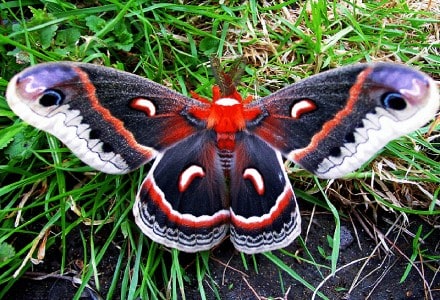
Cecropia Moth Facts
- This stunning variety of Lepidoptera goes by a relatively simple common name. That’s the unflattering term of Cecropia Moth. The scientific name for it, meanwhile, remains that of the tongue-twisting term of Hyalophora cecropia.
- Regardless of which name one chooses to use to refer to it, though, one fact stands out. That’s because the marvel of Nature never fails to impress those who see it. The first known scientific recognition of the arthropod occurred in the year 1758.
- That occurred due to the work of a highly respected individual. None other than the renowned Swedish botanist Carl Linnaeus made that fateful acknowledgement. He first did so, in fact, in his 10th edition of his Systema Naturae, at that time.
- For the moment, it thankfully appears to be maintaining a large and stable population base. This trend further seems to hold true throughout the entirety of its natural range. The IUCN, therefore, presently has no listing for it on its Red List.
- The magnificent Cecropia Moth nevertheless does face the same potential threats as other species. One of those consists of the ever-present danger of habitat loss. Its greatest threat, though, obviously comes in the form of climate change.
Related Species
Luna Moth White Ermine Comet Moth
Public Domain Image
Cecropia Moth Physical Description
The dazzling Cecropia Moth actually manages to impress those who encounter it in a variety of ways. That’s because it evolved to be both beautiful and large for its kind. In fact, it ranks as the largest known variety of moth native to its portion of the globe.
Like many of its relatives, it also displays the physiological trait of sexual dimorphism. In its particular case, this characteristic manifests itself in terms of both size and appearance. The size difference, furthermore, in fact qualifies as relatively extreme.
Females attain an average wingspan of around 6 in (15.2 cm). Exceptional individuals, however, sometimes reach 7 in (17.8 cm). Males, meanwhile, average only a 4 in (10 cm) wingspan. Only the smaller bodied males possess large, feathery antennae.
The fabulous Cecropia Moth also display a dazzling pattern of colors. While the genders differ in other manners, in this both sexes present the same appearance. Both show a bright array of colors. These typically include red, brown, black, white, and orange.
- Kingdom: Animalia
- Phylum: Arthropoda
- Class: Insecta
- Order: Lepidoptera
- Family: Saturniidae
- Genus: Hyalophora
- Species: H. cecropia
Cecropia Moth Distribution, Habitat, and Ecology
The gorgeous Cecropia Moth, fortunately, evolved as native to an extremely broad swathe of the world. In fact, its range ranks as the broadest of any moth in its part of the world. That portion of the globe, furthermore, covers a majority of the continent of North America.
Within that portion of the world, the insect makes its home across parts of the countries of the United States and Canada. In the United States, its area of habitation extends from the Rocky Mountains eastward. To the north, it extends as far as northern Canada.
Wherever it appears, though, it displays decided preferences for its choice of habitat. That’s due to the fact that the great majority of individuals make their home on maple trees. If these aren’t available, however, individuals sometimes appear of birch or cherry trees.
Like the majority of moths, it evolved as nocturnal in nature. During their short lifespans, utilize their furry antennae to track females via their powerful pheromones. The males typically die shortly after mating, while the female lives until she lays her eggs.
Like most moths, the short-lived adults of the Cecropia Moth possess no mouth parts, thus do no feed at all. These therefore pose no threat to any species. Unfortunately, though, they themselves have many predators, including bats and various parasites.
Species Sharing Its Range
Check out our other articles on 4 Amazing New Guinea Species, Black Rain Frog, Christmas Island, Swamp Wallaby, Dead Man’s Fingers, Satanic Leaf-Tailed Gecko, Nicobar Pigeon

